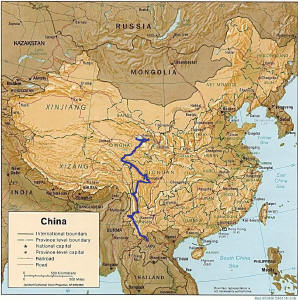 Friday 8 May
2009, Mengla, Yunnan
Friday 8 May
2009, Mengla, Yunnan
 Friday 8 May
2009, Mengla, Yunnan
Friday 8 May
2009, Mengla, Yunnan
Hawk! Spit! Welcome back to China. Mind you they also have this disgusting habit in the north of Laos.
The border was just so easy. Our visas were checked and passports stamped on both sides. Customs check? What is that? No official was interested in any one's luggage. Anything could have been brought into China.
The bus bypassed the toll road and took to the side roads. A bit bumpy but not too bad. Then he turned off onto a dirt road and on to the toll road! Now we had a smooth road with lots of 3k tunnels and many shorter ones all the way to Mengla.
After booking into a hotel we went in search of a meal. There are lots of English signs - actually Chinese written in Roman characters - but the Chinese do not understand them and do not speak English. It does help us round eyes though. Naturally the restaurants had no English menus so it was back to choose and point. Remembering the disaster in Tashkurgan last time I entered China I was not too happy to merely point. This time I used chop sticks and tasted before choosing. The men whose food I tasted had a great laugh and the waitress was pleased because she had no clue what we would want. It ended up a large meal with 4 dishes plus rice. I had expected the dishes to be smaller because there were only 2 of us but they weren't. It was delicious though.
There were many Dai women out for an evening meal. Maybe it was women's night out. Their dresses were lovely and each group all wore the same outfit.
Next morning we caught the bus to Jinghong but Pieter only went as far as Menglun. He had intended to go to another town but there was a mix up - comes from the lack of English by the Chinese and Chinese by us. Also many towns in the area start with 'Meng' just to confuse you.
Saturday 10 to Tuesday 12 May 2009, Jinghong, Yunnan
Elephants everywhere! Not alive, but
statues of all sizes and colours and pictures even on the buses. The reason - Banna Wild Elephant Valley is to
the north. And they are wild. The reserve used to have treetop huts for visitors
and a cable ride over the treetops. The elephants decided that they did not like
the loud noise and flash photography so they pulled all the offending trees
down. The treetop huts have not been replaced!
I didn't go to the reserve. Instead I visited the market at Menghun to see the different tribal women. Men wear western clothes but the women generally keep to their traditional dress, enhanced by modern conveniences like sewn with a sewing machine. I met Felix on the bus and Vanessa and Stuart at the market. The market itself is much like other markets with material, braid, clothing, shoes, vegetables, meat and sundry items for sale. The most unusual being small bottles of animal blood. It is cooked in water to make a traditional broth. What made the market so fascinating was the women. Just watching a whole group haggle about a piece of material for one of them. The shop keeper had a hard time of it. Also taking note of the different styles of dress, all very colourful. There were the real hawkers, women with souvenirs for sale. They were willing to sell the hat on their head if you would buy. They were very persistent. Felix bought some souvenirs to take home and we both bought army canvas shoes. These seemed to be the only item where bargaining was not accepted. All the shops with these type of shoes for sale stuck to the same price, even for two pairs. They are very comfortable and pack up small. Ideal if / when I get to Tibet or go hiking.
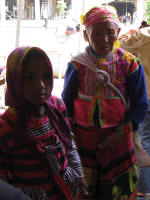
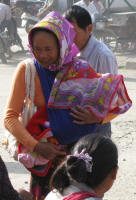
The four of us met up for dinner that evening and had a hotpot. This is a buffet style meal where everything is cooked by the customer in boiling broth. There are multiple foods to choose from- tofu, fish, meat, noodles and all types of vegetables and herbs. I had seen this on my last trip to China but not experienced it. It is a good meal and because it is a buffet we all ate much more than intended.
I enjoyed the Dai style lunch at the market more though. This consisted of a bowl of rice and a variety of dishes from the many available. Between us Felix and I chose 4 different dishes to go with the rice. They were all very tasty. I had this type of meal every day in Jinghong after this.
I also visited the hot springs at Gasa.
The villagers have a separate pool which they use to wash their clothes. Mmmm. The water was not that hot and greenish but it was relaxing as I had the place
to myself. The cashier only arrived after I was in the water. Obviously he was
told there was a customer and came along to collect the entrance fee as I left!
I used the local bus which stopped at Gasa. Then I had to walk through a Dai
village. The houses are built of wood on stilts as elsewhere in S E Asia but
they are large and have a wall around them. Perhaps because they are so close
together. In other countries there is more land between the houses. The newer
houses are built of bricks, plaster and some are tiled on the outside. The new
roofs tend to be blue and the bottom section is enclosed. They must need
air-conditioning to keep these houses cool though because there is no way any
breeze can penetrate.
Oh and I stayed in a private house. As I was walking along the street from the bus station an old man asked if I needed a bed. I nodded and he led me into an area behind the main street where there were lots of shops selling pipes and metal. Rooms in the house have been done up for paying guests. It was clean, had a shower, fan, electrical point and TV. I don't need the TV but the rest was fine including the view over a small lake. There was no receipt so I assume it is truly private enterprise. The family consists of 3 generation and they are very friendly. Couldn't speak a word of English though just like most people in the area. Communication is all in sign language and gestures. There are two backpacker cafes though where I could obtain information in English.
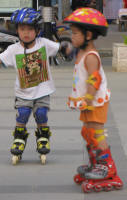
Wednesday 13 May 2009, Xiding, Yunnan
I decided to see the Thursday market at Xiding as this was supposed to be the best of the lot. First I had to go to Menghai and then catch the afternoon bus to Xiding. I decided to find a hotel where I could leave my luggage for the night and then stay for a night after. Since I did not know the town and had no map I caught a rickshaw, supposedly for 3 Yuan. He took me just round the corner and demanded 30 Yuan. Now really! I indicated I could have walked but he was adamant. So I just walked into the hotel which was far too expensive anyway. Eventually he came after me and I paid 3 Yuan. I found a cheaper hotel just down the street and put some clothes and toiletries into my backpack and the computer into the large bag and left most of the luggage at the hotel.
I
had lots of time so I decided to visit the Octagonal Pagoda just out of town. It
was built in 1701, damaged during the cultural revolution and renovated in 1978.
The frescoes around the temple depict the life of Buddha and some have been
renovated. I even recognised some of the scenes but not all as I am no expert on
the life of Buddha. The front on one side has been painted white and donations
have been recorded there including by some westerners. The religion here is
Hinayana Buddhism. It is much more like the Mahayana Buddhism of Tibet, that is
without all the Hindu gods.
Once back in Menghai I waited at the bus station people watching, including a Buddhist monk smoking. I would have thought his religious life would have taken a need for external means of relaxing away.
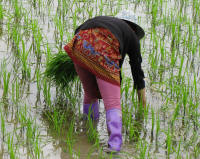
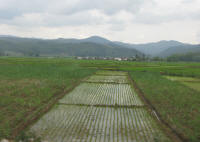 The
road to Xiding goes across a valley full of rice fields already planted, then up
into the hills with terrific views and tea bushes. Unfortunately it started to
rain, not a good omen. I stayed in the dorms at the bus station with a lovely
thick duvet and a hot shower. Around 6pm the local radio started up using the
huge loudspeakers on the top of the hill. Another reminder of Tashkurgan! Is
this something for minorities? There is electricity and quite a few TVs so the
people do not need a loud public radio. I would be interested in what they are
saying.
The
road to Xiding goes across a valley full of rice fields already planted, then up
into the hills with terrific views and tea bushes. Unfortunately it started to
rain, not a good omen. I stayed in the dorms at the bus station with a lovely
thick duvet and a hot shower. Around 6pm the local radio started up using the
huge loudspeakers on the top of the hill. Another reminder of Tashkurgan! Is
this something for minorities? There is electricity and quite a few TVs so the
people do not need a loud public radio. I would be interested in what they are
saying.
Thursday 14 to Friday 15 May 2009, Menghai, Yunnan
The load speakers started up at 6am as well. No need for an alarm clock! The market didn't get started properly until about 8am. It had rained during the night and was wet and cold in the morning. I had not expected this and had brought the minimum, only a change of underwear. I was wearing a sleeveless top as well. At least I had a light silk scarf which I had taken in case I needed to cover my shoulders for the temple. This was barely adequate. Stalls did a roaring trade in raincoats and umbrellas. So now I also have an umbrella. Perhaps the rain put a dampener on everything but there were very few different tribes there, mainly the local villagers. Most women had western style jackets on as well against the cold so it was not as good as Menghun. I spent some time having a noodle soup breakfast so I could watch the people while under a hastily erected plastic cover. The stall holders had to constantly cover their goods then uncover them as soon as the rain stopped. I am not sure they had a profitable day.
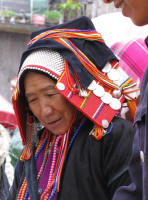
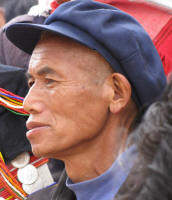
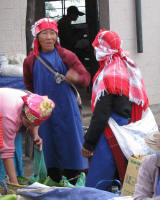
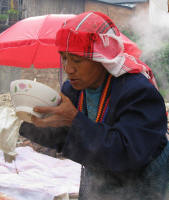
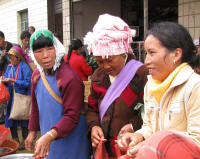
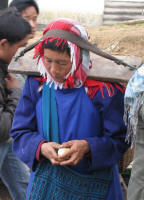
There was only one bus back and because I stayed at the bus station a seat was held for me and I was called to come and pay. Another young American did not realise you had to go to the makeshift ticket office. By the time I had bought my ticket and told her to buy hers it was already too late. The bus was full. She is a university student at Kunming and had come to visit the local school so I do hope she found a ride back. Certainly a motorcycle would not do in the rain.
I relaxed in Menghai, caught up on washing and e-mails. I tried the Mandarin word for Internet but no-one understood me! Back to the gestures again.
Saturday 16 May 2009, overnight bus to Tengchong, Yunnan
Fantastic scenery with hills, valleys, lots of natural vegetation, rice paddies, tea plantation, tobacco and other crops. The road started well then parts were being upgraded and eventually we came to the original road, rocks embedded in dirt - old fashioned cobble stones! It made for a bumpy ride. The hills took their toll on the cooling system. We had to stop several times to fill the radiator with water, or at least a large tank which presumably fed the radiator. No such thing as filtered water either, it came straight from the local water supply which came from streams. At least we all had a chance to stretch our legs and have meals. There was a toddler on the bus in disposable nappies. Very considerate as she did not wee on the floor. It looked rather strange though to see the nappy sticking through the split in the back of her pants. And what happened to the dirty nappy? It was pushed through the window! Disposable nappies are not biodegradable so it is very environmentally friendly not to use them. Mother and child got off at Boashan and by this time the toddler was back to no nappy.
Sometime well after dark we went through a police check of the luggage, except mine. They were very thorough. Maybe they were looking for drugs or perhaps pig products. China are taking swine flu very seriously. All ids were checked and my passport was taken away, I assume to someone who could read English.
At Boashan I had to catch a different bus to Tengchong. By the time I arrived I had spent 25.5 hours travelling and although not exhausted, after all the first bus was a sleeper, I was not at my best. I asked where Rehai Lu was and the street outside was indicated. So I decided to walk. Then a motorbike taxi said no that was not true and I could not walk to Rehai Lu. I decided to go with him. When we headed out of town I tried to say this was not right. I also made him stop twice to check and make sure we were heading for Rehai Lu. Each time he said not to worry it was OK. Eventually he proudly pointed to the hot springs, apparently called Rehai locally. Obviously he saw a good catch and refused to hear the 'LU' for street. At least the scenery was interesting. He took me back to town and to a hotel just up the street from the bus station. I could have walked! And I had to pay for both journeys. At least he carried my bag up the stairs. I had to laugh at my stupidity there is no point getting angry.
Sunday 17 to Tuesday 19 May, 2009, Tengchong, Yunnan
After booking into the hotel, having a lovely hot BATH and a change of clothes I headed into town to a food court. I asked many people where the street with the food court was. I did find out the correct pronunciation but no-one knew where it was. I even showed the Pinyin words to young people who could read it but had no idea where the street was. A lot of people refused to even try to help. The most helpful were some Chinese tourists who since they were not local also did not know. They asked a local in Chinese and the local did not know. By now I had decided that the local residents had no clue about their own city. I found some small restaurants and had a meal to break the frustration and at least satisfy my hunger. I decided to go back to the hotel and try again the next day. Then I saw an expensive hotel, always a good source of information. Guess which street I had been walking up and down? That's right, the one I had been looking for! Now at least I was orientated.
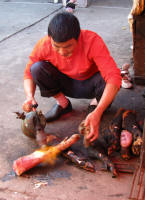
A good nights rest and I was ready to see the sights. The area has several extinct volcanoes. They have been dormant for 3,800 years. The area has rare hexagonal basalt. The LP indicated which street to head for and I had no trouble finding it. There were supposed to be mini buses going to the volcanoes. No such luck. A motorcycle stopped and I showed where I wanted to go. The price was 3 Yuan so I was happy to go to where she took me. This ended up being a bus stand not in the LP. From there I could easily catch a bus to Mazhan.
It is a long slog up the stairs to the top of Dakhong Shan (Big Empty Hill). I rested frequently and enjoyed the prolific azaleas but eventually made it and found Dan and Lucy at the top. Dan is Israeli, Lucy English. What a pleasure to find someone with whom I could converse! We ended up staying together for the day. This included spending a long time chatting under a shelter while it rained quite heavily. My umbrella really came in handy. We walked around the Big Empty Hill, then down and up to Heikong Shan (Black Empty Hill). Yes there was some black lava there on the sides of the empty hill. Between the two hills they are building a new road using the black lava as a base. The woman cook(?) showed us the sleeping quarters and the kitchen. The workers all bed down in a dorm with very few facilities except a bed. There must be a place to wash somewhere though and there are plenty of bushes for the other.
Back at the entrance we watched an old man shaping volcanic rock into plant holders. He had quite a few for sale filled with various plants. He was absolutely delighted to see his photo. In the village we sat down and had a good meal before catching the bus back to Tengchong. Then the effort of getting back to the hotel. I walked with Dan and Lucy until Dan saw a number 2 bus which goes past my hotel. I had a lovely hot bath again. It was so nice to lie back and let the heat work on my legs. Then into bed.
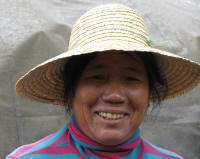
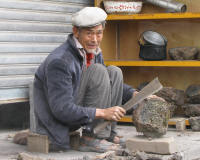
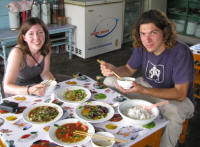
Next day I decided to try the number 2 bus from the hotel because I needed to go back to the same bus station to get to Yunfeng Shan. I was dropped at a round-a-bout 50 meters from the bus station! What bliss. It was easy to catch the bus to Gudong. From there I took a shared taxi. I was the first passenger and had to wait for quite some time for the taxi to fill with another 4 passengers. While waiting I had quite a conversation about where I came from and who the others were. I had the LP with me and one of the guys realised that it had Chinese writing. He used that to ask me questions. It was great fun. Of course for a lot more I could have had a taxi to myself and this was offered several times. The other passengers got off at a small town called Heping while I was taken to the entrance of Yunfeng Shan. There is a cable car which cost a lot more than the entrance fee. Once at the top the LP said it was a 20 minute walk to the temple. The LP neglected to mention it was almost straight up! There was a chain rail guard to help me with posts topped by lions. And here I thought it would bean easy day physically. At least there is a restaurant at the top and I had a good vegetarian lunch all be it cold because it was after 2pm by now. The view from the top is magnificent. The Taoist temples are as expected with statues of various deities and murals on the walls. The ying yang circle is used often. Going down to the cable car was not so bad. At the bottom of the cable car a taxi driver was waiting. Presumably he had just brought the people on their way up. The price was the same so I assumed we would pick up more passengers at Heping where there was a market. I had about half an hour to wander around in the market. A dentist was actually at work right there. He was pulling out a tooth but the woman did not seem to feel any pain, maybe he had used some local anaesthetic as I did not see any needles. He carefully cleaned his instruments afterwards with cotton wool and alcohol. Reasonably hygienic but not for me. He had false teeth for sale as well. Once back in Tengchong all I had to do was walk outside the bus station and wait for the number 2 bus to come past. There are no specific bus stops so it is a matter of waiting anywhere on the route.
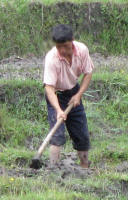
Wednesday 20 to Friday 22 May, 2009, Dali, Yunnan
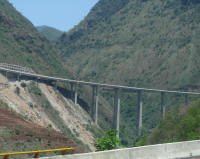 There did not seem to be a
direct bus from Tengchong to Xiaguan (New Dali) at least
according to the ticket office. I later found out there were 2 daily. In any
case I caught the bus to Boashan. I had noticed on the journey out that there
was a new road with lots of bridges over valleys and clinging to the side of the
mountains plus long tunnels. This time I really took note. It is a marvel of
modern engineering, on a par with Italy. There was a police checkpoint on the
way out. They are not worried if you are going west only if you are coming from
Myanmar. We were stopped although other buses rolled through. One man had to go
to the office. He took longer than the check of my passport. Once I arrived in Boashan I asked for
the bus to Dali. The last one left in 10 minutes! Just lucky I guess. Onthe way
we passed a mosque. The nearby houses has paintings of the mosque on their walls
in Dali style. I guess the people are both Bai and Muslims. At Xiaguan (New
Dali) I walked down to the number 4 bus station to catch the bus to Old Dali.
There did not seem to be a
direct bus from Tengchong to Xiaguan (New Dali) at least
according to the ticket office. I later found out there were 2 daily. In any
case I caught the bus to Boashan. I had noticed on the journey out that there
was a new road with lots of bridges over valleys and clinging to the side of the
mountains plus long tunnels. This time I really took note. It is a marvel of
modern engineering, on a par with Italy. There was a police checkpoint on the
way out. They are not worried if you are going west only if you are coming from
Myanmar. We were stopped although other buses rolled through. One man had to go
to the office. He took longer than the check of my passport. Once I arrived in Boashan I asked for
the bus to Dali. The last one left in 10 minutes! Just lucky I guess. Onthe way
we passed a mosque. The nearby houses has paintings of the mosque on their walls
in Dali style. I guess the people are both Bai and Muslims. At Xiaguan (New
Dali) I walked down to the number 4 bus station to catch the bus to Old Dali.
Once in Old Dali I headed for the same hotel I had stayed at last time but was approached by a hotel manageress and told they had the best rooms in town. I bargained for a 20% discount before even agreeing to see the room. Well she was right. I have a lounge room, a bedroom with a double bed and a bathroom, plus 2 TVs (wonderful for someone who rarely watches TV). The hotel is built in the style of a mosque and my large round shower with 2 different shower heads is in the minaret. The two bed rooms look pretty standard, a bedroom with chairs and a small bathroom.
The first thing to do was to find out about Tibet. On the way to one hotel which arranged such things I met Dan. He intends to go to Tibet as well so we went along together. The hotel no longer arranges anything for Tibet. We then went to another hotel Dan knew of. They needed 4 people for the trip. I also checked at Jim's Peace Cafe and he also needed 4 people. Both hotels agreed that there would be a better chance in Shangri-la. Dan met up with some friends and we ended up chatting and later going to eat together. It was a lovely evening but long. I ended up only getting back to the hotel after midnight.
This meant a day of rest then it was time to get out again. I have been thinking about learning to ride a bicycle so I hired one. I just rode down to the lake, had a walk around and then rode back. A few kilometres only but more than enough. I learnt to ride reasonably straight, to start without going all over the road and come to a controlled stop. I only fell twice. This means I have spent almost 2 hours on a bike in my life. If I keep practising a bit more frequently I am sure I will be come proficient.
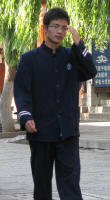
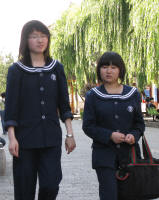
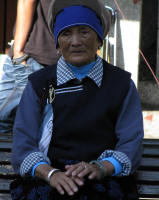
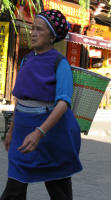
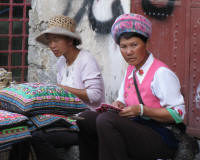
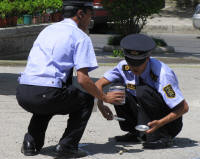
After lunch I decided to visit a Bai village and walk around. I had heard of Xizhou and decided to go there. It is an ancient town set up for tourists, not quite what I was expecting. In fact 'town' is the wrong word, it is basically a large sprawling house containing shops for the Chinese tourists and a theatre where Bai songs and dances are performed. We were also given 3 cups of tea in the Bai tradition. The first was normal green tea, then sweet almond green tea followed by sweet cinnamon green tea. They used a lot of sugar! The songs were about how the boy (or girl) was too shy to talk about their love for the other party. Interesting the girls sang and played their instruments (maybe) but the boys didn't even try to look like they were playing the instrument or singing. The best was a song and dance about pinching the bride. The more she was pinched by anyone and everyone the greater the blessings on the marriage. The performers had a great time.
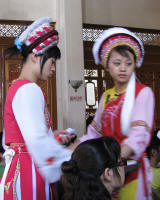
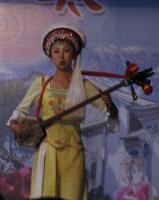
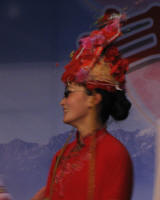
Saturday 23 May 2009, overnight bus to Zhongdian (Shangri-La), Yunnan (elevation 3200m)
Being Saturday I had a choice 7am minivan or 8:30pm sleeper bus. So I took the sleeper bus. I have been this way before and 10 hours on a day bus is worse than a sleeper. I do hope I do not have to come back again. I am really hoping to get to Tibet.
Sunday 24 May 2009, Shangri-la, Yunnan (elevation 3200m)
I do not know what time we arrived in Zhongdian. All I know is the bus stopped and everyone kept sleeping until about 6 in the morning when the local people came along in their noisy trucks and motor bike trucks to unload the bus. It is difficult enough to sleep in the bus but when the chickens start squawking, people climb on the roof and open the luggage areas underneath, sleep becomes impossible. I had to wait until another truck moved away from one side of the bus before I could get to my luggage. At least I could lie in a bit. Naturally I had a lazy day. I scouted around for information on Tibet and put up several posters asking for companions. Then basically dozed until the dorm started to fill up. By 10pm there were 5 of us ready to hire a minivan and go to Mingyong Glacier the next day. We are a mixed group. Erin is Chinese and speaks English, he did most of the negotiating; Mike is American and speaks Chinese with a smattering of Korean; Lee is Korean and speaks English; Chong Hoon is Korean and speaks Chinese, he can understand most English though. Between us we had enough languages to communicate. The driver could only speak Chinese and I can only speak English.
Monday 25 May 2009, Feila Si, Yunnan
The journey took long time because we stopped at all the sights along the way. Also because the road wound over two mountain ranges, there were many road works in progress and trucks took up the width of the road. It could be scary turning a blind corner to find a truck on our side of the road. Both drivers quickly moved and prevented an accident. I am surprised we didn't see lots of car wrecks. The first sight was Napa Hai (Haphacuo Lake) a lake with many bird species from September to March. Naturally it was dry now and not much to look at. We did not visit Dhondrupling Gompa as we had all seen plenty of monasteries. Then there was Yue Ya Wan (Beach Like a moon) which is a bend in a river which feeds into the Yangtze. On entering the Baima Snow Mountain Reserve we could see some of the mountain range between the clouds but mainly prayer flags. The area has been a place of Buddhist pilgrimages for ages. I went to town on taking photos of Yaks nearby. There are several chortens at the check in centre for Mingyong Glacier. Again lots of prayer flags, views of the mountains and pilgrims burning Juniper and incense. We could actually see the glacier at that stage. Villages and fields took up any relatively flat area and looked pretty with mountains soaring up behind them.
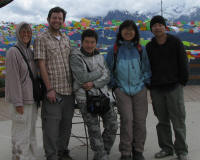
We stayed in Feila Si which is the closest town to the glacier. We wanted to see the sunset and sunrise over the glacier and mountains from the hotel. Both were dismal because of the clouds.
Tuesday 26 May 2009, Deqin, Yunnan (elevation 3550m)
We were all expecting the car to take us to the viewpoint for the glacier. No such thing. It was at least a 2 hour trek from the car park to the top! Of course horses were available for a price but we all decided to walk. By this stage the others all knew my age and were concerned about me. They waited for me to rest when I needed to even though I told them not to worry about me and did not charge ahead as they could have done. Mike actually preferred going slowly. Chong Hoon took many short cuts. The horses loved getting close to the walkers. They seemed to deliberately come as close as possible. Even when we stepped off the path onto the ledge near a long straight drop down the horses came close. A few times I slapped their sides to move them away. Once I was almost pushed over the edge. And the dust! The path was loose dirt and their hooves created clouds of dust. We all came down absolutely covered with dirty clothes and gritty faces. The last part up was on wooden paths hanging from the mountain side - no horses allowed. We met some older women coming down carrying backpacks for tourists, presumably younger tourists! The clouds prevented a good view of the mountain itself but we could see the bottom section of the glacier clearly. The glacier is 12k long and tumbles down Kawa Karpo (6740m). We could only see the bottom blackish section close up. Further away we did get a view of a higher section. It did not creak and groan like the one at Fairy Meadows in Pakistan, rather there was the sound of running water. The blue of some sections was great. We had Yak butter tea before descending. Hot water is placed in a churn with butter and a milky slightly salty brew comes out. Doesn't taste too bad. We were also given some roasted barley. Apparently you put some in your hand, pour on some tea and make a paste which you then eat. This is a staple for Tibetans. The taste was nutty but preparation a bit messy. The downward trek was comparatively easy.
On the way back we stopped at Mingyong Village to buy wine. French missionaries had introduced grapes a few hundred years ago and taught the local people to make red wine. It was quite sweet but we bought some. It was taken from a barrel and poured into an empty water bottle!
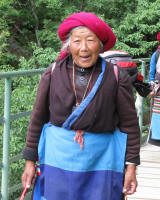
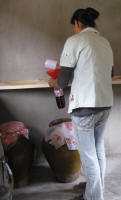
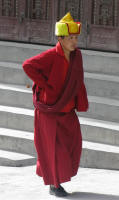
We had expected to stay at the Lucky Hotel in Feila Si to allow the driver to have 2 nights free accommodation. The hotel had no showers for the dorm beds but there were 2 doubles with showers and a single room in between. We understood that we had booked the 3 rooms in the morning. When we arrived at the hotel the rooms had been given to other people and we had been assigned a 3 bed room and a 2 bed room on the 4th floor. The smelly toilets were on the 2nd floor. This was not acceptable to any of us. Unfortunately all the hotels were either full or did not have showers. After a much needed meal we returned to Deqin and found a hotel with a 3 bed and a 2 bed room, both with hot showers. What bliss to wash away the dust. We all slept like logs.
Deqin is the last outpost before Tibet. Maybe I'll be back
Wednesday 27 to 31 May 2009, Shangri-la, Yunnan (elevation 3200m)
The return journey was quick because we did not stop any where. Lee knew of a restaurant in Shangri-la which had Yak meat, Yak cheese and sweet Yak milk tea. We had a farewell late lunch together. Lee stayed in town another day to see the horse festival but the other 3 moved on that evening.
The horse festival was interesting. The opening ceremony had singers and dancers. The dancers were different Tibetan groups in their traditional dresses with different coloured scarves. Each group moved in and out of other groups in a sedate dance making a colourful sight. The races were another story. First 2 horses at a time showed their form. Some of the riders rode bareback, others had stirrups. Eventually there were about 3 races. To start the race the horses and riders were led to the start line (a white line in the dust) and more or less held there by the handlers. Then the race started. some horses went off straight away, other jockeys took a few seconds to realise the race had actually started. Not that it mattered. By the time the horses had gone around 3 laps there was already a clear winner even though the length of the race was 6 laps. The end runners gave up at this stage and pulled out of the race. After the races 2 horses at a time showed their paces and it became boring.
The women came in all their traditional finery. The men wore western style clothes. I took more photos of the audience than of the horses. The festival was to take 3 days but it rained on the second day and the festival was stopped.
The army cleaned the stands between the time the crowds left after the opening ceremony and the races
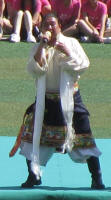
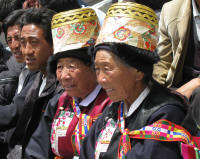
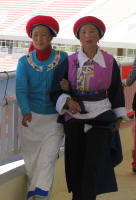
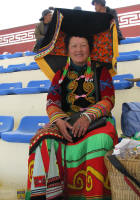
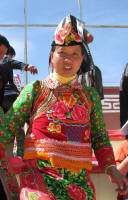

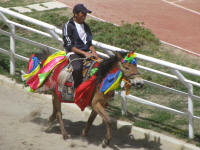
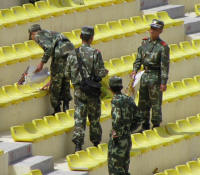
Shangri-la has an old town which is where my hostel is. There is a town square. Each evening the local people come and dance for a few hours. The children know the steps of the dances presumably by copying their parents. Once again the women dress up and the men come in western clothes. The dances are all performed in a circle with reasonably simple steps. I joined in and although not fantastic I did manage to follow some of the dance steps with the arm movements.
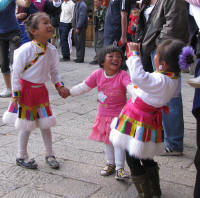
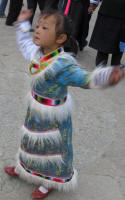
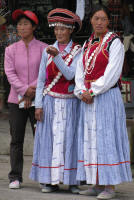
A monastery at the edge of the Old Town has the largest prayer wheel in the world. I went up there with some travellers I had met and walked around the expected 3 times. There is another monastery north of town but the entrance fee was 65 yuan. I have seen enough monasteries so I decided the price was way too high. In the Old Town Square there was Lada honey for sale. I would like to know how it is formed as it looks like multi coloured rock but is sweet like honey.
One of the sights worth seeing is the Gesar Thanka Museum. King Gesar, born in Sichuan, lived around 950 CE. He united 15 tribes and was considered an enlightened ruler. He is also considered the son of a God. Over the years an epic song was developed around his life and exploits. It is the longest epic in the world with more than 120 volumes, 1.5 million lines and 15 million words. Gesar culture is widely spread and the epic is still sung throughout Tibetan areas today. The epic has been designated a Chinese National Intangible Cultural Heritage by the government.
In 2002 a project was initiated to paint thangkas telling the epic story. Each thangka is in the form of a scroll 2m high 1.4m wide with silver poles at top and bottom. There is the actual painting and an explanation in Chinese and English underneath. The explanation is in gold and VERY difficult to read which is unfortunate as without the explanation the paintings become less interesting. The paintings use valuable natural mineral and plant pigments so flash photography is not allowed. The photo I took does not do the painting justice, the colours are much more vivid. They are done in the Tibetan painting style as Gesar was Tibetan. It took 100 painters 5 years to complete 1288 thangkas. They went on display in 2007. Thangkas are still being painted today so the final total will be much larger.
There is a film about the decision to paint the Thangkas, the committee, the selection of the painters and the painting methods used. Selina and I visited on the last day of free entrance.
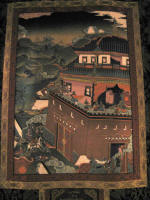
Monday 1 to Tuesday 2 June 2009, Xiangcheng, Sichuan (elevation 3600m?)
I had spent the last couple of wet,
cold days in Shangri-la with Selina from Switzerland and since our plans tallied
for the next few days we decided to travel together. The road out of Shangri-la
soon turned into mud because of the recent rains. Eventually the surface did
improve until we finally reached tar. There are a lot of road works in progress
but not much maintenance. Water channels beside the road are full of rocks and
other debris which have slid down the mountain side. Bamu Tibetan Guest House is
magnificent. It is a typical fortress style Tibetan house built of stone with large rooms, 3 floors, a flat
roof and no internal heating, water supply or toilets. The outside walls are
insulated by cupboards on the inside. The dorm walls are
painted in the Tibetan style with lots of detail and gold paint. There is barely
any surface that does not have a picture painted on it. There is a hot
shower and toilets, both outside.
We had to be up at 5am to catch the bus. This we managed. Unfortunately we did not realize there was a ticket office hidden away up some stairs. I assumed you paid the driver. By the time we found out, after standing around freezing for over half an hour, the two buses for Litang were sold out! Later we were told by another traveller that the office was open at 8pm. Maybe the woman has two jobs. We could have caught a minivan but the price was far too high. We now had a day free and went straight back to the Guest House for a sleep. There is very little to do in Xiangcheng except window shop along the main road, eat and visit a Buddhist Gelugpa Monastery. The temple must be about a kilometre from town and uphill all the way. The sun was out and it was a pleasant walk. Surprisingly there was an entrance fee and a monk to guide us around. He indicated we could take photos with the gesture of taking one and the noise of a clicking camera - delightful to hear. The temple is much like other Tibetan Buddhist Temples although I was surprised to see a statue of a many handed god. The best part was watching monks making a mandala out of fine grains of colour. This will be destroyed once it is finished to show the impermanence of life.
You could also buy caterpillar fungus (yartse gompa). The caterpillars burrow into the ground for winter, die and are taken over by a fungus. They form in the grasslands and are harvested by Tibetans who then sell them to dealers in Tibetan towns, after cleaning off the dirt. They are considered valuable medicine for anything. There does not seem to be a specific use nor have its benefits been scientifically quantified! Each caterpillar is sold for several US dollars and by the time it arrives in the consumers hand (Japan and Korea) it is worth more than its weight in gold.
Wednesday 3 to Thursday 4 June 2009, Litang, Sichuan (elevation 4014m)
Scenes from the wild west; modern horses (motorbikes) decorated with blankets and bunting; men and women walking around spinning small prayer wheels; women dressed in traditional Tibetan clothing including Han Chinese women; men dressed in traditional clothing with their hair held back by thick bands of wool. Litang is not about sight seeing but people watching in a traditional Tibetan town set amid hills, all above the tree line.
The journey started out badly with a driver going fast and swinging around the curves. Great when you sit in the middle seat of the back row with just an aisle in front of you! Several people suffered from motion sickness, including the man in the aisle seat in front of me. He was given a plastic bag but only used it for a short while. The floor was easier. Oh well it was possible to take a big step over the mess and it did not smell. Amazing how you can become grateful for small things. Another driver took over later and he drove much more slowly round the curves - something more to be grateful for. There was one police check where our visa details and the names and ids of the Chinese were recoded.
The weather in Litang was variable, from freezing cold to boiling hot in minutes. We did do some sightseeing, to the Chorten to watch people circling it reciting mantras and spinning the large prayer wheels and to the Gompa built for the 3rd Dalai Lama.
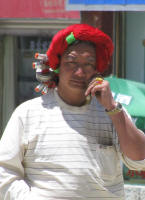
Friday 5 to Sunday 7 June 2009, Kanding, Sichuan (elevation 2616m)
The journey from hell! The start was
tarred but bumpy, then the potholes came. The road deteriorated from here to
rocks, dirt and road repairs. Selina and I were in the second back seat this
time. Sometimes the driver seemed to forget that there were passengers at the
back and went flying over huge bumps in the road. We all went flying up in our
seats landing with a thump. Occasionally it was so bad there were loud
complaints to the driver. It actually created a companionship among the back
seat passengers as we were all in the same boat and since we could do nothing
about the situation we laughed just as you would on a fun fair ride. 11 hours is
much too long for a fun fair ride though. Once again a woman in front
suffered from motion sickness. She could open the window though and stick her
head out. That part was good. The icy cold wind blowing in at 7am was not.
Selina copped the worst of it as she was on the aisle and the wind went straight
through her. I seemed to get less wind coming directly for me on the window
seat. The woman's husband was very concerned about her and about us. He
comforted her when she was being ill and was careful to close the window after.
It was better later in the day when the outside air had been warmed by the sun.
The driver had to constantly stop and fill the radiator with water. This seems
to happen on every bus trip. At the top of the pass which was above the snowline
and must have been over 5000m the driver had to change the tyre. He did it with
all passengers on board. Thank you Mr Driver for not making us stand outside in
the cold and the rain. The we headed down, down down over roads under repair
with all the attendant flying through the air or waiting for trucks to be filled
with dirt and trucks and cars heading uphill to pass. At one stage after the
truck was full of dirt and had moved off we had to wait for 8 trucks and 3 cars
before we could continue. Other times the bus had to backup on the slippery
surface to a wider spot so a truck or 3 could scrape past with centimetres to
spare. There are several rumours as to why the road is so bad; A) the earthquake
a year ago damaged the road and it is still being repaired; B) the government
builds poor roads which are destroyed each winter to create jobs for the
summer; C) the government does not provide sufficient capital to build good
roads. Take your pick.
Of course our intended destination was Tagong and we were supposed to get off the bus at Xinduqiao. and catch another bus to Tagong. Xinduqiao is the town before the high pass and long downward drive, about halfway to Kanding. We did not realise it when we arrived at the town at mid-day and stayed on the bus for another 4.5 hours of torture! We were very surprised to arrive in Kanding.
Kanding is very much a Han Chinese town although there are Tibetans around. There are also a lot of new modern buildings but they are much like decorated square towers. China has some magnificent modern buildings but these were not designed by their best architects. There are monasteries to visit and mountains to climb but mainly it is a place to rest up after a very tiring journey. Selina only stayed 2 nights before heading to Danba and then Chengdu. From all account the road between Danba and Chengdu was very badly affected by the earthquake so she might go to Tagong and once again take the road from hell. I am definitely going on that road again to Tagong and further west.
Oh and it is so nice to be relatively warm and not so breathless.
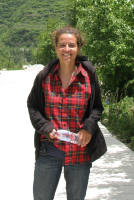
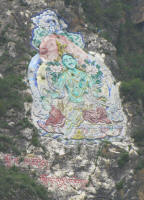
Monday 8 to Wednesday 10 June 2009, Danba, Sichuan (elevation 1800m)
What did I just say about returning on the road from hell? No buses go to Tagong from Kanding! I went to the bus station to buy a ticket and was told "your don't going" literally - it was written on a piece of paper to make sure I understood. I could of course have gone to Xinduqiao and then caught a minivan to Tagong, or caught a minivan to Tagong from Kanding. I decided to skip that road and go to Danba then on to Tagong from there.
It
was a much better idea. The road was infinitely better although not perfect.
Tunnels and bridges are being built to improve the journey along with a
hydro-electric power scheme. The road followed a river through a narrow canyon
giving great views. At one stage we stopped for 40 minutes. I thought it was
because of a landslide but later I heard they only let traffic through 3 times a
day because of the road works. The result was a long line of trucks. At least
the trucks left space between them and the bus overtook many trucks once we
could move. We had another stoppage. This time because of a single lane, single
car bridge.
Danba as a town is nothing to write home about. It is spread out along the Daduhe Canyon making it a very long narrow town where they use every inch of space. The majority of the population are Zang and the women have different headdresses to other tribes. It does have Tibetan villages nearby where there is an entrance fee and watch towers. Many of the houses outside of town have small 'towers' on the corners of the roof, presumably in imitation. However I decided I needed a break and did very little. The weather is warm and the elevation perfect. Very little did include a visit to the viewpoint for the Suopo watch towers (free) and a long walk along a minor road leading out of town. The air was fresh and cool. It was great to get out into the countryside. I saw a woman turn a 20kg bag of rice into a backpack using straps. They must have cut into her shoulders, but her home was up the mountain side and this is the best way to carry the bag up.
I tried to obtain a bus ticket to Bamei and was told to come back in the morning before 7:00 when the bus left. Not a nice prospect. I spoke to one of the owners of the hotel who could speak English and he arranged a ride with his friend for 9:30 the next morning - much more civilised.
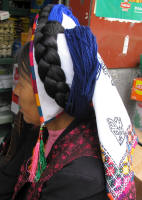
Thursday 11 to Friday 12 June 2009, Tagong, Sichuan (elevation 3600m)
The road wasn't too bad mainly through
a river valley. I saw men bathing in a pool by the river and when I commented I
was told it wasn't cold (all this in sign language). I assume there was a hot
spring which fed into the man-made pool as the river water would have been icy.
Several hills had forests of prayer flags. They looked quite spectacular. When
we arrived in Bamei, after delivering spring onions to 3 different restaurants,
the driver found another minivan to take me to Tagong. It was over an hour
before the van had sufficient passengers to leave, the joys of travel.
Selina was still in Tagong. She had only spent 1 night in Danba. We went for a short walk around a hill to one of the many monasteries. The religious service was just ending so we stopped to watch the monks come out and walk around a field. Once they were all out standing in a square it was time to disperse. We decided to continue along the road in the expectation it would lead around another hill and back to town. Of course it didn't so we decided to climb over the hill back to town. What a climb! We must have gone up at least 100m, very tiring at that altitude. Mind you I would have had problems doing the climb at sea level. There were animal tracks and the way was more or less smooth and with 3 rests we made it. The rests gave me plenty of time to look at the different flowers. Downhill was just so much easier, like going down steep steps. That was me for the day.
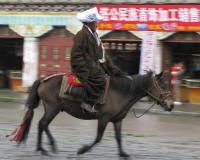
Phillip from Canada was one of the guests and he had organised to hire a minivan with driver and translator for 10 days so he could stop when he wanted to take photos. He is a keen photographer and had the equipment to prove it. He intended to do a loop through Dege and I asked if I could join him to Dege. He agreed.
Of course I had left my dirty clothes soaking and now had to wash them and hope they dried before morning. I also wanted to make sure my feet were warm as the first night it took hours for them to warm up in bed. The solution is to stand in a basin so my feet are standing in hot water. I stood on top of my clothes and while showering stamped up and down to wash the clothes at the same time. Not a good idea. The basin slid across the floor, I fell down and sprained my left wrist. Oh well I have sprained both ankles in the last 4 years I guess it is time to start on another part of my anatomy. Selina wrung the clothes out as I could not do that and they did not dry by morning just as I had expected.
Saturday 13 June 2009, Dawu, Sichuan (elevation not known)
Phillip and I left at 9:00am and headed to Bamei. I had seen some sort of festival at the temple on my way to Tagong and it was still going. Apparently the people were being taught lessons. It was interesting to see the crowd. Not everyone was paying attention though. One group were cleaning candle bowls; another group drying them and putting new wicks into the hole in the middle; another group took them into a special room, filled them with oil and lit them. The room was nice and warm. There was a man selling saddle blankets nearby. He had a lovely silver saddle for sale as well. These people were certainly not paying attention to the lessons.
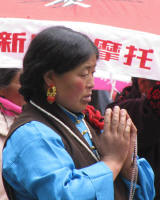
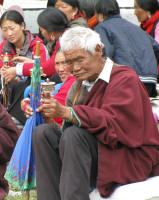
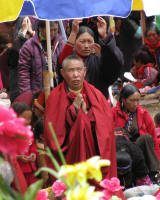
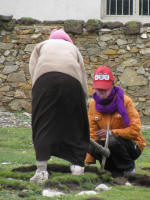 We
stopped a few times for photographs of the scenery and once at a monastery. To
get to the monastery we had to leave the main road and climb up a gravel track
which happened to be smoother than the road!. To get back to the main road the
driver went over the grass and mud! While there we took a walk around the
village. Forest could not explain why women were cutting
turf and putting it on their fences. I should have asked him to ask the women.
My surmise is that the grass, even when dried out, provides protection for the
wall. I would love to know for sure though as it is a hard job to cut the turf
from the cold ground.
We
stopped a few times for photographs of the scenery and once at a monastery. To
get to the monastery we had to leave the main road and climb up a gravel track
which happened to be smoother than the road!. To get back to the main road the
driver went over the grass and mud! While there we took a walk around the
village. Forest could not explain why women were cutting
turf and putting it on their fences. I should have asked him to ask the women.
My surmise is that the grass, even when dried out, provides protection for the
wall. I would love to know for sure though as it is a hard job to cut the turf
from the cold ground.
Once in Dawu it took some time to find a hotel that had decent rooms. Dawu is not normally visited by tourists. They usually go through to Ganzi. But of course we took much longer to do the journey as we stopped often to take photographs. Much better than whizzing by the spectacular scenery.
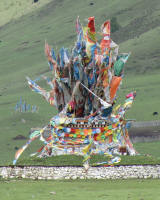
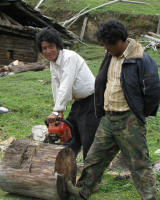
Sunday 14 to Monday 15 June 2009, Ganzi, Sichuan (elevation 3394m)
Besides driving slowly and taking in the wonderful scenery we went up a side valley which was quite spectacular. Naturally there was a monastery and prayer wheels. Both Forest, the translator, and the driver, whose name I never did find out, spun the wheels.
At the top of a high pass (over 4,500m) we stopped near some nomads and bought yak yoghurt. The yoghurt is similar to cow yoghurt. Our sample was a little sour. A Tibetan teacher, who teaches children at a nunnery about the Tibetan way, of life also stopped. I took a video of her explaining the use of dung. I do hope she had a good microphone as I could hardly hear her.
The houses have changed slightly in appearance. There is a lot of wood used for the upper stories.
Ganzi has expensive but poor accommodation. The cheaper rooms near the bus station were good but there was no electricity in the communal ladies facilities. I ended up in an expensive hotel. In my room most of the lights worked and there was a hot shower even if you had to work it without handles on the tap. Phillip's room had peeling wallpaper, a few lights worked and the shower didn't. So much for paying high prices!
We spent a leisurely day visiting some of the sights including the Ganzi Gompa built in about 1660. It is home to some 400 monks. There are hundreds of small golden Sakyamunis in cases along the walls of the main hall.
We drove around to 2 other Gompas mainly for the views. These are spectacular when the clouds lift. There is snow on the higher mountains and green hills in between. It is a beautiful area, but then the whole trip has been through magnificent areas.
Tuesday 16 to Wednesday 17 June 2009, Dege, Sichuan (elevation 3270m)
Shall I use the same word again? Spectacular doesn't do it justice really.
We did not expect to make Dege in a day based on past days, but we did. We were at Manigango, the turnoff to Dege, by lunchtime and kept going.
First stop after lunch was Holy Yulong Lake just outside of Manigango. It is a clear glacier lake. Phillip was not very impressed but then he has seen lots of these lakes. There was a large group of monks packing up and many small prayer papers littering the ground near the lake. I think they are at least biodegradable. Naturally you could ride a horse for the short walk from the entrance to the lake.
Then up and over Chola Pass, a 5,000m pass through the mountains. The top of the pass was festooned with prayer flags and included an arch. We stopped many times and drank in the scenery. I took so many photos that I ended up deleting over half because they were basically the same. How else do you record the beauty? Not that a photo does it justice.
The way down from the pass was through valleys and finally a canyon with sheer multi-coloured rock sides. By this time it was late afternoon with insufficient light to take decent photos unfortunately.
We passed 3 monks on their way to either Dege or Lhasa. They pray the entire way, taking 4 steps forward then stopping to do the Buddhist genuflection with a full prostration. It takes years to complete the journey to Lhasa.
Dege is a holy town for Buddhists because of the printing monastery. The printing house is over 270 years old and houses over 270,000 wooden blocks of Tibetan scriptures from the 5 Tibetan Buddhist sects and comprises over 70% of Tibet's literary heritage. Dege is also full of beggars many of them dressed as monks and begging off monks. We had already encountered these 'monks' in Ganzi where there was a particularly aggressive trio. Dege has the most though and they are not very old either, maybe mid twenties.
I visited the monastery with Phillip then it was time to say goodbye. He intends to travel south along the Tibetan border to Litang, definitely a less travelled route. I stayed another night.
Dege is built along a canyon with houses either climbing the hill or cut into the rock. Naturally every available space is well used. Wood is used for the upper stories.
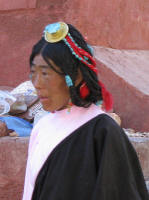
Dinner was fun. Phillip had taken his
room key. Hotel management could not speak English so asked some Chinese guests
to translate. Once that was sorted out I was invited to dinner with the group.
There were 7 of them with a driver and 2 4x4s, driving to Lhasa. How I
wish I could go along! Anyway dinner was full of laughs. It started with the
meal. They specifically wanted to have a traditional spicy fish. Unfortunately
the monks had bought all the fish and thrown them back into the water. We ended
up having a traditional soup instead made with offal, bean sprouts and lots of
spice. Plus the usual plethora of other dishes. There was beer, green tea and a
cola concoction. The cola concoction is made of Coka Cola mixed with hot water
and ginger - tasted very nice thank you.
Thursday 18 June 2009, Manigango, Sichuan
I slept most of the way back to Manigango over the pass. Guess my body decided rest was more important - been there seen it. I had to stay the night as the next bus to Sershu or Yushu was not until early in the morning. I spent the afternoon resting and watching the hotel staff, 3 old women and a policeman cleaning mushrooms for the restaurant. The women were then given the leftovers from the restaurant. People always buy too much food and then leave half. The women were 61, 63 and 70. They all looked much older to me. Makes me realize how lucky I am with my health.
Manigango is a small town so I managed to slowly walk all over in about an hour. It has a claim to fame though because King Gesar of Ling was born in the grasslands to the north. The headdresses are different again. They are very elaborate and consist of a large stone on the top of the, another at the back and strings of beads connected to ear-rings and / or belts. Most Tibetans wear there coat with only one sleeve on and the hanging down showing the lining. The coat has a belt and the top is used as a pocket to carry items - including babies! I took a photo of the manageress of the restaurant. She wore her coat without using any sleeves, making a brilliant splash of colour around her waist
Friday 19 June 2009, Sershu, Sichuan
Next morning I was up early hoping to catch the bus from Ganzi to Yushu. David, an Australian and a Chinese man wanted to go the same way. A minivan driver started negotiating to take us to Sershu. He started at 200RMB each but eventually dropped to 150RMB. When the bus did not stop we took him up on the offer.
On the way we passed many nomads on the move. They use some of the yaks to carry their possessions including 2 young children in baskets.
Naturally by the time we arrived in Sershu it was too late for transport to Yushu. This meant staying the night in a cheap monastery guest house. Once again, as in Manigango, no shower facility or even a basin!
And again the headdresses were different.
Saturday 20 to Sunday 21 June 2009, Yushu, Qinghai
And an early start the next morning. The bus did not leave until late morning so David and I were at the taxi rank by 7:00am. We were immediately offered seats in a minivan for the same price as the bus ticket! Wonderful. We even had time for breakfast while the driver waited for his pre-booked passengers to arrive. The road goes over a 4,700m pass into Qinhai Province. It is bad on the Sichuan side and good in Qinhai. Only one Tibetan was sick. Where she managed to find something to bring up I don't know. But about every half hour there was another cup full to spew out until Qinhai when the road was so much better.
I definitely wanted a shower. David stayed in a monastery guest house again but I found an unusual room. The bathroom was also the hotel laundry! This meant I had a washing machine which I made good use of, as well as a shower. Amazing.
The next day started with a visit to the Ga Kye Gu (Jyekundo Dondrubling) monastery. This was originally built in 1398. At the moment a new Temple is being built. I spent some time sitting with the people who look after the candles and listening to the prayers. They were not finished by the time I left so I did not go inside.
Back in town I met a young 14 year old girl, Selina, whose English was very good. We spent the afternoon together, visiting her house and just walking around. She has a 64 year old Grandmother who, once again, looks older. Westerners generally age much better. Her parents are nomads and stay in a tent throughout the year so Selina stays with her grandmother, 2 aunts and their husbands and children. Very lively.
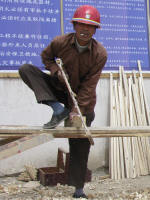
Monday 22 June 2009, overnight bus, Qinghai
Typical sleeper bus. At least because the
roads are good no-one was ill. Unfortunately the man above had very smelly feet
which was unpleasant until he covered them with the duvet. This time the bus
stopped to pick up extra passengers. They had to sit and sleep on the floor! At
least they got to Xining.
The geography eventually more of less flattened out. There were fences around paddocks near several villages. The first time I had seen them other than around fields with crops. We also passed through a boggy region with lots of lakes.
Tuesday 23 June to Saturday 10 July 2009, Xining, Qinhai (elevation 2300m)
The LP is way out of date for Xining. The hotel they recommend no longer takes foreigners. I arrived about 6 in the morning and had to wake the security man to get in, then wait for reception, then wait for some-one who spoke English to find this out. Eventually I was taken to a Youth Hostel on the edge of town where Chinese usually stay. I have a 6 dorm bedroom all to myself as they are not busy. The hostel has mattresses made of cardboard, squat toilets, free wifi, free use of the washing machine (I later found out I should have paid!) and hot water showers if you have the patience to wait 15 minutes. I can have 5 showers in that time! There were some westerners, MIT under-graduates and a graduate doing workshops on website development for an NGO.
What did I do for so long? Completed the income tax, updated the website (not online though), sorted out the trip to Tibet and kept up to date with the basics of living.
I did eventually do some sightseeing. The Provincial Museum is being renovated and only had 1 of 6 sections open to the public. It had some 2,900 yr old material on display along with carpet weaving, Thankas and Buddhist statues.
The best was an overnight trip to Qinhai Lake
(elevation
3,200m). I did not do the usual correct thing and
check where I was supposed to go to get to Dino's, a place on the lake
recommended by Tibetan Connections. In fact I just bought
a ticket to Qinhai Lake. On the bus I met Theresa and started talking. She was
much more organised than I and had bought a ticket to Heima He. When
we arrived at Heima the conductor checked the tickets and found I had not paid full price.
I had to pay a small fine.
Serves me right of course. I phoned Dino so he could pick us up and discovered I had caught
the wrong bus! We decided to get a taxi to Niao Dao (Bird
Island) as we knew there would be accommodation there even if the birds had
moved on. Theresa could speak Chinese and asked if there was another place we
could stay. The driver stopped at a Tibetan family who had 2 tents for guests.
Double bed, soft mattress, lovely. The price included food as there was none nearby.
We spent a blissful evening strolling along the lake shore of rocks. Dinner was a meat and
vegetable soup with heavy home made bread. I slept like a log as there was no noise except the
waves on the rocks. Next morning it rained. We had breakfast of rice pudding no sugar,
and left on 10:30 bus. The lake itself is just that. Blue skies beautiful blue water,
grey skies white water. The journey was pretty though - rape in fields of yellow flowers on
hills and in valleys as ascended to the lake and descended back to Xining.
The Tibetan Medicine Museum has
medical Thankas and the Great Thanka. The Tibetans did autopsies and so understood
the functions of the body 1500 years ago, way ahead of Western and Chinese medical science.
Knowledge included the development
of a baby in the womb. One Thanka on the development of the foetus was great. It showed
the spirit of
the child entering during sex. Generally the Thankas had very explicit drawings. As with
Vedic medicine the
bowel movements were very important and graphically illustrated. The Great
Thanka is a recent one. It was commissioned by the Chinese government to
represent Tibetan culture and Chinese influence on Tibetan culture. It is 618m
long (over half a kilometer!) and 2.5m wide. It goes on forever. The Thanka
starts with creation and Tibetan history, then Sakamuni (the historical Buddha)
in various poses, Arhats, guardians, mandalas, all the leaders of the different
sects except the current ones and including the Dalai and Pancha Llamas plus
famous Chinese scenic spots. It took over an hour to walk the length.
Ta'er Si (Kunbum in Tibetan) is one of the 6 great monasteries of the Gelug (Yellow Hat) Sect of which the Dalai Llama is the head. The first meditation hall was built in 1560 close to the birthplace of Tsongkhapa, founder of the Yellow Hat Sect. Today it consists of various halls. I went with Joan who had arrived the night before. We decided to first walk around as most people were doing. It was only when we went to see the Yak Butter statues that we were stopped. I suppose they are more particular here as the statues have to be kept in an air-conditioned room to preserve them. Outside there are the usual vendors selling food, souvenirs and photographs in fake Tibetan clothing. There were also artisans hammering pictures and writing into copper plates.
Beishan
Si is a set of Taoist Temples from 300 CE on
a hill near the city. The temples have been carved out
of the hillside. One set of murals was fascinating. They
showed what happens if you lead a bad life. Very imaginative torture. There was
one small picture of the good going to heaven.